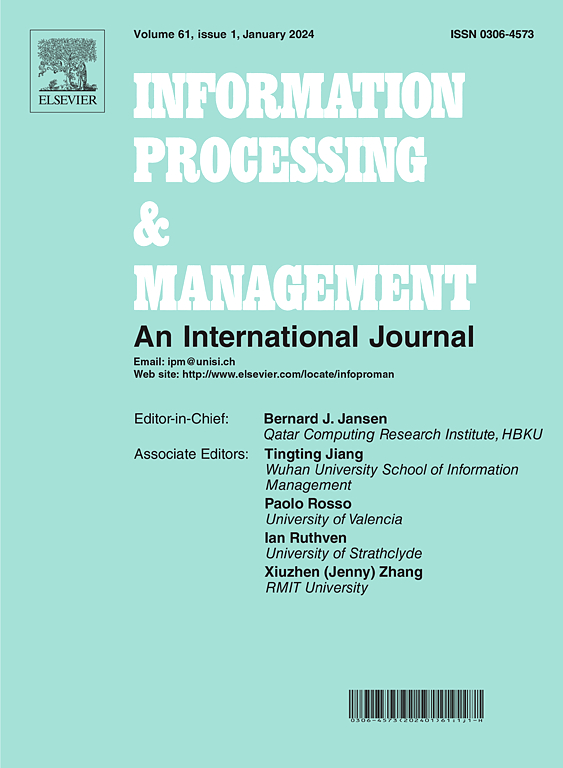Concept cognition over knowledge graphs: A perspective from mining multi-granularity attribute characteristics of concepts
IF 7.4
1区 管理学
Q1 COMPUTER SCIENCE, INFORMATION SYSTEMS
引用次数: 0
Abstract
Humans can better understand and answer questions than machines because they know the cognitive knowledge related to the concept in questions. To equip machines with the cognitive knowledge required for cognizing concepts, concept cognition over knowledge graphs in this study involves mining the cognitive knowledge required by machines, i.e., multi-granularity attribute characteristics of concepts, which enables machines to distinguish or cognize concepts from multiple granularities. First, an algorithm is proposed to mine multi-granularity attributes characteristics of concepts from concept-related knowledge in a knowledge graph, i.e., frequent attributes and attribute values of concepts from multiple granularities. Second, the monotonicity of the multi-granularity attribute pattern is proposed to promote synergy among granularities and accelerate the mining process because the result from coarser granularity can serve as a candidate for the result from finer granularity. Third, the representativeness of the maximal frequent attribute pattern is used to unleash the value of above monotonicity and accelerate the mining process, which enables the algorithm to mine maximal frequent attribute patterns with fewer quantities to derive all frequent attribute patterns in large numbers. Finally, the experiments show that the above algorithm is more efficient than baseline algorithms, the monotonicity of the multi-granularity attribute patterns can accelerate the mining process, the representativeness of the maximal frequent attribute patterns means that the percentage is always less than 5%, the percentages of correctly classified instances by the multi-granularity attribute characteristics are always higher than 90%, and the above classification performance performs better than existing machine learning algorithms at most cases.
基于知识图的概念认知:挖掘概念多粒度属性特征的视角
人类可以比机器更好地理解和回答问题,因为他们知道与问题中概念相关的认知知识。为了使机器具备认知概念所需的认知知识,本研究的知识图概念认知涉及挖掘机器所需的认知知识,即概念的多粒度属性特征,使机器能够从多个粒度中区分或认知概念。首先,提出了一种从知识图中概念相关知识中挖掘概念多粒度属性特征的算法,即多粒度概念的频繁属性和属性值。其次,提出了多粒度属性模式的单调性,因为粗粒度的结果可以作为细粒度结果的候选,从而促进了粒度之间的协同,加快了挖掘过程;第三,利用最大频繁属性模式的代表性,释放了上述单调性的价值,加快了挖掘过程,使算法能够以较少的数量挖掘最大频繁属性模式,从而获得大量的所有频繁属性模式。最后,实验表明,该算法比基线算法效率更高,多粒度属性模式的单调性可以加速挖掘过程,最大频繁属性模式的代表性意味着其百分比始终小于5%,多粒度属性特征正确分类实例的百分比始终大于90%。在大多数情况下,上述分类性能优于现有的机器学习算法。
本文章由计算机程序翻译,如有差异,请以英文原文为准。
求助全文
约1分钟内获得全文
求助全文
来源期刊

Information Processing & Management
工程技术-计算机:信息系统
CiteScore
17.00
自引率
11.60%
发文量
276
审稿时长
39 days
期刊介绍:
Information Processing and Management is dedicated to publishing cutting-edge original research at the convergence of computing and information science. Our scope encompasses theory, methods, and applications across various domains, including advertising, business, health, information science, information technology marketing, and social computing.
We aim to cater to the interests of both primary researchers and practitioners by offering an effective platform for the timely dissemination of advanced and topical issues in this interdisciplinary field. The journal places particular emphasis on original research articles, research survey articles, research method articles, and articles addressing critical applications of research. Join us in advancing knowledge and innovation at the intersection of computing and information science.
 求助内容:
求助内容: 应助结果提醒方式:
应助结果提醒方式:


